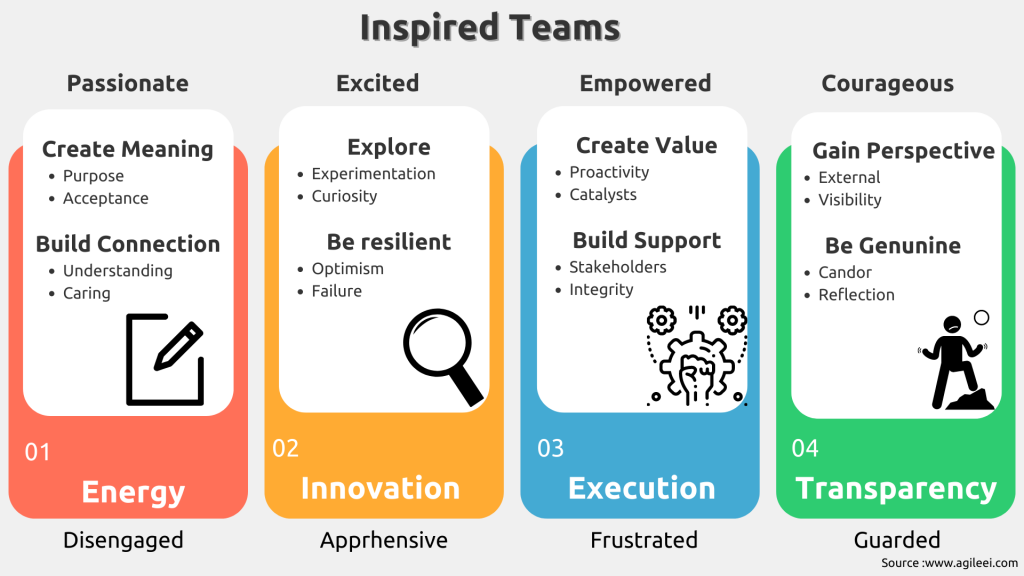In a previous article, I discussed the importance of the “happiness hormones,” endorphins, in Agile coaching. Driving the adoption of Agile rituals requires discipline and dynamism, and to maintain these states, we need a reward system. Rewards aren’t only results; they’re also the emotional impact of reaching those goals. That’s why, as an Agile Leader, boosting happiness hormones among the team is key. Here, we’ll look at another of these all-important chemicals: dopamine.
Dopamine is another type of neurotransmitter, that is, a chemical messenger that our bodies make to send messages between nerves. Endocrinologists describe dopamine as our own internal “reward system,” and therefore, it plays a key role in how we experience enjoyment. It’s a big part of what keeps us motivated, focused and interested.
In an Agile context, you’re constantly trying, testing and adjusting, so you need to sustain the motivation to keep striving towards this common goal. When products are so dynamic and changeable, incremental rewards are vital – and that’s why our physiological reward system, dopamine, plays such an essential role. Our Agile Emotional Intelligence approach benefits from the Inspired Teams™ Framework.

Before we discuss the importance of dopamine in Agile methodologies, we’ll look at why Agile itself is so useful in a product management context. Let’s jump in.
Table of Contents
Why is Agile good for leadership?
Agile began life in the software world, where teams used it as a methodology to develop new products. The twelve Agile Principles enabled teams to test and tweak products before taking them to market in a way that saved vast amounts of time and money. Instead of spending, say, a whole year developing something whose flaws were only evident once it was in the marketplace, Agile allowed the team to refine their work incrementally.
Since, Agile transformation has bled out of information technology-based work into broader business practices, demonstrating various benefits for day-to-day operations, from boosting efficiency to promoting results-based collaboration within and outside the organisation’s four walls. Now, leading businesses in nearly all verticals use Agile, including Apple, British Petroleum, Ericsson, AstraZeneca, IBM, UK Government and Barclays bank. For example, when Barclays applied Agile to the operations of more than 800 teams, they saw a 300% increase in throughput.
Agile is still enduringly popular for product-based work despite adaptations into broader contexts. The methodology’s development cycles or “sprints” incorporate stakeholder and customer feedback to hone the product. Agility isn’t only applicable in software; now, due to the fast-paced global business environment, this focus on evolution, collaboration, flexibility, and high stakeholder engagement is ideal for most product development.
To sum up the key benefits, Agile product management delivers:
- Higher quality because incremental testing facilitates regular checkups and continuous improvement.
- Reduced risk as Agile product management mitigates absolute failure through these incremental improvements.
- Increased product visibility as regular Scrum meetings and sprint reviews allow for greater transparency and control.
- Greater predictability is facilitated by shorter development cycles that allow product managers to make more accurate predictions about costs and the timeline.
What makes for a successful Agile Leader?
Sounds good, right? But these results don’t just materialise out of thin air; this dynamism requires motivation and motivation needs to be nurtured. For those who’ve attended my training sessions, you’ll know I always say that to be truly Agile, you need to have an Agile mindset. To apply an Agile mindset, you need to be motivated, and to be inspired, you need to be happy.
We all know the feeling. You’ve achieved something and you’ve done an excellent job. Even if the process was long and littered with setbacks, the sense of accomplishment at the end makes it all worth it. That’s the dopamine kicking in. So how can an Agile Product Manager facilitate these dopamine rushes throughout the product development lifecycle?
A fundamental principle of Agile is clear goals. Goals get set within a short timeframe, within the sprints. These sprints are crucial to giving the team opportunities for dopamine release. These goals mean there is light at the end of the tunnel and the light is always more or less in sight, especially when you’re using a KanBan board – and nothing gets the dopamine moving than putting a task into the “done” column.
Even more, dopamine gets released during daily stand-ups and Scrums. During daily stand-ups is where the Scrum Master will update the team on product progress – but what is the difference between Scrum Master and Agile Leader? It is worth mentioning as a quick aside for those that aren’t entirely au fait with Agile. The Agile Leader will oversee the whole operation, including managing schedules and budgets and liaising between the team and stakeholders. Meanwhile, the Scrum Master takes a supporting role in facilitating communication between team members during these meetings.
These meetings are not only important, so everyone is up-to-date on the product itself; they also nurture human connection. It also creates a space for encouragement and accountability, where team members can make an earnest pledge to reach the next milestone. It is also an environment where team members feel pride and excitement about their progress.
Here’s one quick tip: I often ask my trainee Scrum Masters to put a green tick on the story card when the task gets done, clearly marking that the Product Owner has accepted the work. This simple exercise does wonders for morale, or rather, dopamine levels.
Daily dopamine for the advanced Agile Leader
All that said, I’m more than aware that many readers here aren’t new to Agile. “Been there, done that!” many will say. For the Agile aficionados needing fresh ideas to boost their team’s dopamine level, here are a few tips you can apply quickly and easily. They’re new ideas, but none of them is particularly complex – and with good reason. I’ll get to that shortly.
For one, you can try highlighting the completed story cards in the “done” column to acknowledge how far you’ve all come as a team. In this ceremony, you could also take time to give individual team members recognition for their achievements. Remember: it’s more important to highlight instances where team members supported each other rather than rewarding individualistic heroism.
Need to take things up to another gear? For advanced teams, I recommend inviting stakeholders to demo sessions. If there’s space in the budget, you could even reward the team by ordering in some food; it’s basic, but I find that motivating people with food can do wonders. No matter how complex the product, or high the stakes, we’re simple creatures at the end of the day!
Yes, you might be thinking, “this is far from rocket science” – and that’s true. But the fact is, when it comes to daily dopamine, simplicity is powerful. Motivation techniques need to feel authentic, or else people don’t respond. Transformation expert Ron Carucci wrote in the Harvard Business Review, “When leaders look like they are just applying some ‘motivational technique’ they read about, people see right through the superficial, obligatory effort.” The moral of the story? Keep it simple and keep it genuine.
Embrace random acts of kindness
On the subject of being genuine, I’ll conclude by highlighting what I believe to be the most crucial dopamine driver. Perhaps the most natural and effective way to release dopamine is the giving and receiving of kindness. Whether this is achieved by helping a teammate out of a sticky spot or volunteering for a good cause, the feel-good factor is fuelled by dopamine. These simple things will warm even the stoniest of hearts, so I recommend giving it a go.
Here are a few specific things that you can implement every day. These tips are authentic and accessible and, therefore, significant dopamine drivers. I try to do these three things at least once a week to stay motivated and brighten up my day. Some of them apply outside work because, as we all know, your mood at work and home are not mutually exclusive events.
Here are my three favourite strategies:
- Take a stressed-out teammate out for lunch and let them know you acknowledge and appreciate their effort. Appreciation plus the food is a killer combination, elevating moods all around.
- Remember that task you were going to put off until tomorrow? Challenge your inner inertia, take the first couple of steps to start it and experience a reduction in the mental block. Try to do it now. Getting it out of the way will do wonders for your motivation, even if it’s non-work-related. Everything from emailing a colleague to calling a family member will give you that sought-after feeling of achievement that triggers a dopamine boost.
- Give something back. This is a dopamine booster that’s most effective outside of the work environment, but make no mistake, you’ll carry these good vibes into the office. Volunteering at a community project or donating to a cause you care about will help you feel more positive towards yourself and others.
I like to think of these as a little challenge. Try to cross out all three to boost your feel-good factor every day. As an Agile Leader, you’ll notice the difference if you encourage your team to drive their dopamine levels. You can keep the body’s internal reward system ticking by creating little milestones within the product roadmap and out.
Source Agile expertise with Outvise
The Agile mindset is all about motivation. As an experienced Agile Coach, I take a scientific approach to motivating teams. This motivation means keeping happiness hormones high in and outside of the office. For me, it’s not just a method; it’s a lifestyle.
This feeling is perhaps why I enjoy freelancing so much. It’s dynamic, rewarding, and constantly changing, so my internal reward system is always fired up. This passion is a common sentiment within the freelance community, perhaps why it’s grown so much in recent years.
Outvise is filled with motivated, experienced professionals (like me!) ready and waiting to take on their next challenge. If you’re looking for an Agile Product Manager, Scrum Master, or Agile Coach to inject some life into your product or organisation, look no further. All Outvise’s experts are fully certified and located globally, so an inspiring Agile expert is just a few clicks away. Explore the platform here.
His passion is to help you find mindful motivation and purposeful productivity while developing future leaders and change catalysts for making this world a better place.
Having trained 2000+ professionals, delivered 100+ master classes in 10+ countries, developed 100+ coaches while saving £200M+, Naveed lives lean and breathes agility. For the past 20+ years, he has been enabling talent from global enterprises to local startups in translating vision to strategy to agile & lean execution with an overall aligned and shared vision globally.




No comments yet
There are no comments on this post yet.